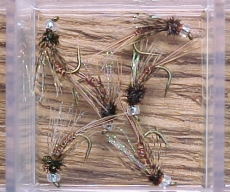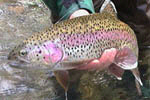 I had an interesting evening this
past summer with this fly. My family enjoys camping in Southeastern
Minnesota, generally in the state parks. Southeastern Minnesota is
part of the "Driftless Region," a 3,000 square mile area also
spreading into Southwest Wisconsin and Northeast Iowa, which was
bypassed by the glaciers of the last ice age. It is an area of
rugged limestone topography, cold springs, forests, and excellent
trout fishing. Several of the state parks have excellent trout
streams. Of course, being state parks, the streams get some of the
heaviest fishing pressure of any trout streams in the state, over
7,000 angler-hours per mile.
I had an interesting evening this
past summer with this fly. My family enjoys camping in Southeastern
Minnesota, generally in the state parks. Southeastern Minnesota is
part of the "Driftless Region," a 3,000 square mile area also
spreading into Southwest Wisconsin and Northeast Iowa, which was
bypassed by the glaciers of the last ice age. It is an area of
rugged limestone topography, cold springs, forests, and excellent
trout fishing. Several of the state parks have excellent trout
streams. Of course, being state parks, the streams get some of the
heaviest fishing pressure of any trout streams in the state, over
7,000 angler-hours per mile.
At the park we were in, the
campground area is only 50 yards or so from the stream, so that
particular stretch of stream gets fished heavily, primarily by bait
fishers. Throughout the day there are people fishing this campground
stretch; folks fishing for trout for the pan, dads and their kids,
and kids old enough to fish on their own. I usually leave this
stretch for them to enjoy, and go to some other, less fished areas.
Early one evening I had only an
hour or so to fish, and there happened to be no one else on this
reach of stream, so I decided to fish there. I didn't have hopes for
noteworthy fishing, just an hour on the stream before the bats came
out. The stream in this stretch makes a wide bend with rip-rap along
the outer bank, and the current has created a deep channel, making
ideal holding water for the trout.
Since the sky was darkening, and
there were no fish rising, I tied on the PT Krystal Variant, with a
split shot and strike indicator, and started fishing at the bottom
of the bend. Almost immediately I was onto a fish, a pretty 12"
brown. Quickly fought and released, I again cast to the rip-rap, and
was soon onto another fish. During the course of my hour or so, I
caught 12 nice fat browns in one of the most heavily fished 200
yards of stream in the state.
I attribute my success that
evening to two things. First, I have come to the conclusion there's
fishing pressure, and then there's fishing pressure. While there may
be thousands of angler-hours put in on those 200 yards, I think the
trout have come to learn that worms are not to be trusted, and
subsequently they don't get caught very much on bait. I caught more
fish in that hour on a fly than had been caught on that stretch all
day on bait. So while the State authorities may conclude this stream
is heavily fished, I no longer believe that bait fishers do as much
damage to the trout resources as I had previously. A reasonably good
fly-fisher can put a lot more pressure on the trout, by actually
catching them, than a bait fisher does by casting his worm to wary
trout.
Secondly, I attribute my success
to the PT Krystal Variant. Underwater, the fly has a good
silhouette. The Krystal Flash and glass bead reflect light like the
air bubble diving caddis bring down with them. Most caddis dive
underwater to lay their eggs, rather than skittering across the
surface as most anglers assume. In low light conditions, this fly
does a wonderful job of imitating these types of caddis. It is
equally effective in cloudy water after a rain. However, I have seen
fish run for cover when this fly is used in clear water on bright
days, like a firecracker went off nearby.
Easy to tie, realistic looking,
and effective to fish, what more can we ask for in a
fly?



